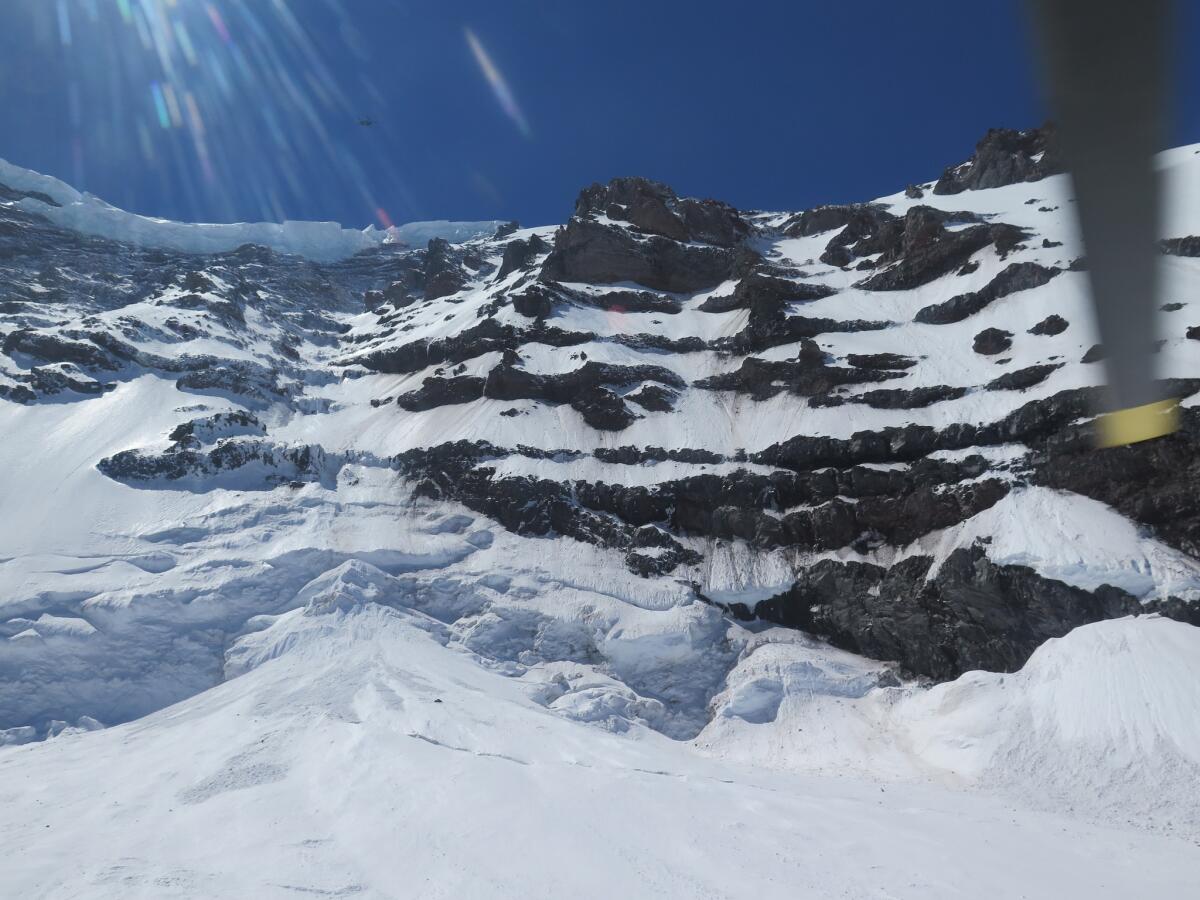6 Mt. Rainier climbers presumed dead; families head to Seattle

- Share via
Four mountain climbers and two guides escorting them to the summit of Mt. Rainier were presumed dead after searchers found a trail of scattered equipment on Saturday, authorities said.
Gary Harrington, operations director for Alpine Ascents International, which was leading the expedition, told the Los Angeles Times that families of the six were traveling from around the country to Seattle on Saturday night. Authorities did not immediately release the climbers’ names, but a family member identified one of them as Mark Mahaney, a 26-year-old from St. Paul, Minn.
The company told reporters that the lead guide with the group was Matt Hegeman, who was also a regular on Mt. Shasta in Northern California.
Rescuers flew over the glaciers of Mt. Rainier National Park on Saturday morning and early afternoon looking for the climbing group, which was last heard from 6 p.m. Wednesday by satellite phone.
The searchers could see camping and climbing gear on Carbon Glacier about 9,500 feet up the 14,400-foot mountain, the fifth-tallest mountain in the Lower 48. As they got closer, authorities picked up pings from emergency avalanche beacons apparently buried in the snow. By late afternoon, park officials said that they believed there was no chance of survival because “all indications point toward a fall of 3,300 feet from near the party’s last known location.”
“This incident represents a horrific loss for our guide partners and the families and loved ones of every one of the climbers lost on the mountain,” park Supt. Randy King said in a statement. “The climbing community is a small one and a close one, and a loss of this magnitude touches many. Our thoughts are with everyone affected by this tragic accident.”
Mahaney had reached the summit of Mt. Rainier before, but this time around, he was trying a new route -- the Liberty Ridge route, one of the toughest and deadliest ways up the mountain.
“Nothing will be easy on this climb,” he wrote on his Facebook page last month.
During Easter, a family member told him not to make the trek. “There’s nothing going to stop me,” he said, according to his uncle, Rob Mahaney.
Mahaney, 53, said by phone Saturday night that his nephew would only talk about two things: mountains and his girlfriend. His Facebook page was filled with photographs of both.
Mark Mahaney regularly went to an indoor rock climbing gym, never missed a chance to scale walls of ice and had dreamed of heading to Mt. Everest someday.
“He just loved the exhilaration,” his uncle said. “He was a very energetic child, and climbing just kind of filled his niche. This is what gives us a warm feeling -- he was doing what he absolutely loved.”
Nearly 11,000 people attempted to scale Mt. Rainier in 2013, and in most years about half of those who try reach the top, according to National Park Service statistics. Forty rescue operations were required last year.
Since 1897, at least 89 people have died on Mt. Rainier during summit climbs, according to the park service. In June 1981, 11 climbers were killed after being buried under giant chunks of ice in what’s widely regarded as the worst climbing accident in U.S. history. Since then, an average of one death has been recorded each year on Mt. Rainier.
“This mountain and Carbon Glacier is very dynamic, with continuous rockfall and ice fall,” a park spokeswoman told KOMO-TV. “No one is immune to that, no matter how skilled you are.”
About 200 people were on the mountain about this time last year, which is considered early in the climbing season. Some of the climbs on Mt. Rainier can be completed in a few hours, though most people take two or three days to reach the summit.
The climbers at the center of Saturday’s search were reported missing Friday evening, when they didn’t return to the trailhead as scheduled at 4:30 p.m.
Last week the park service reported the Liberty Ridge route as being in good condition with soft snow on the ground during the day. Snow flurries passed through the national park late Wednesday.
The climbers were at nearly 13,000 feet on Wednesday night when they radioed in to the offices of the Seattle-based guide company, which is one of three that operate on Mt. Rainier.
Five Sherpas from Alpine Ascents were among the 16 people killed in April on Mt. Everest in the Himalayas. They were struck by an avalanche in what is believed to be the deadliest accident on the world’s highest mountain.
The second deadliest climbing disaster in the U.S. is believed to have occurred on Oregon’s Mt. Hood in May 1986. A blizzard froze to death seven students and two teachers from the Oregon Episcopal School.
Officials at Mt. Rainier said it could be weeks or months, if ever, before the climbers’ bodies are recovered from the hazardous terrain. Aircraft are expected to fly over the site regularly to monitor it as the snow melts.
More to Read
Sign up for Essential California
The most important California stories and recommendations in your inbox every morning.
You may occasionally receive promotional content from the Los Angeles Times.














